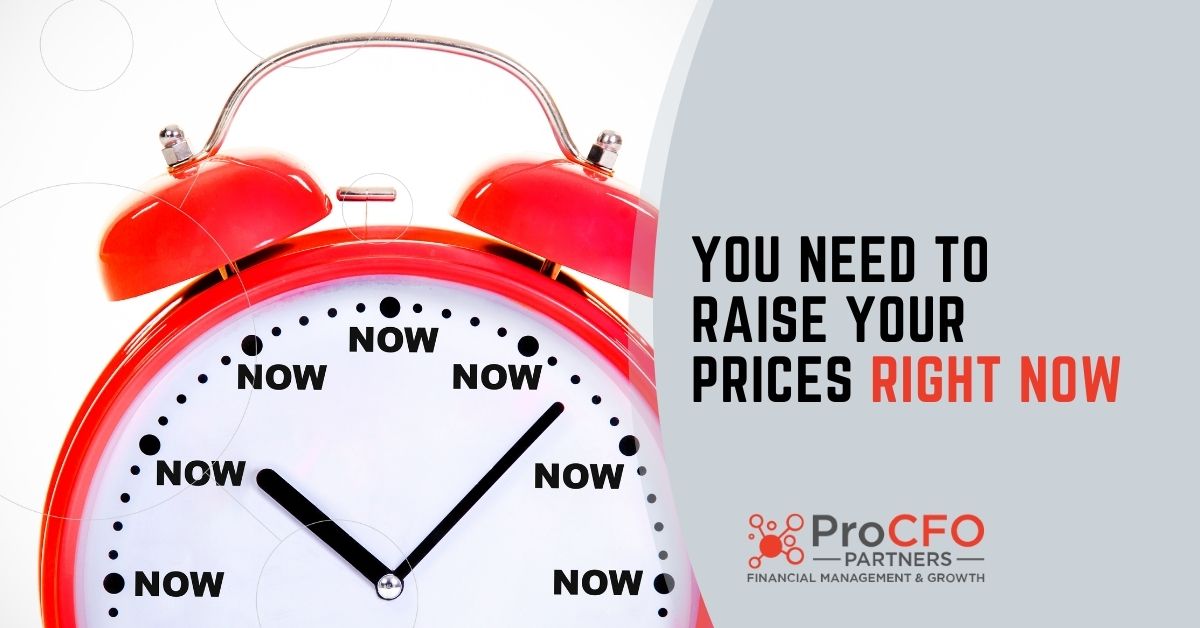Raise Your Prices Right Now
Jun 1, 2022
Inflation coming so quickly off the heels of the pandemic is creating cash flow and revenue issues for many organizations. In this article, we’ll explore how once-in-awhile price increases, especially knee-jerk reactions to outside dynamics, aren’t the path to sustainable growth – or even survival. Read on to explore the value of implementing regular, predictable, reasonable price increases that your customers can understand and manage.
Look at Your Market
Haleh Fardi, ProCFO Partners Chief Visionary Officer and Co-Founder, illustrates a common issue with a story from Portugal.
After touring an olive farm, the farmer shyly offered patrons an opportunity to buy a bottle of olive oil for €12. Then, almost immediately, he started sharing how you could buy a bottle for less at the grocery store.
Haleh asked him, “Why not charge €15?” The farmer replied that he was making enough for a small profit. Meanwhile, oil and supply costs are increasing everywhere, and the farmer wanted to create a job program for the youth in his small village.
The farmer had significant capital needs coming up, like wanting to purchase his own olive press. Yet with a captive audience of mostly American tourists, he was reluctant to increase his prices. Haleh’s guidance for the farmer – for all of us – is to look at your market.
Understand Your Value
In the case of this Olive farmer, his market consisted of people who – by nature of being tourists – had a few dollars to spend and had driven a few hours to a farm with 200-year-old olive trees. His product isn’t just olive oil – it’s the experience people are having. The functional value of olive oil isn’t even very interesting to this market. They’re happy to have a souvenir of their experience. They’re happy to have an authentic memento of their time not only at his farm but in Portugal. For this market, olive oil is part of a story to tell and remember. And people would’ve likely paid three or four times what he was asking, and been happy to do it.
We’re not all selling olive oil or even products. But we must understand the value of our services beyond the cost of goods or material supplies.
For most organizations this means understanding if you’re saving your customers time, saving them money, or, in the case of the olive farmer, creating an experience for them that’s unique. Knowing what your customers value most about you helps you understand how to better relate to their needs or expectations.
Understand Your Realities
Your pricing should be in relation to your revenue model and your goals and strategies. Your margins should account for expenses and profitability. These are the fundamentals and are one reason why your financial reporting is so important.
Many organizations, especially in small and mid-markets, have a general sense of their metrics and measurements but lack nuanced, timely insight. There are a few causes for this:
- Key Performance Indicators, goals or even margins that were set years ago, when the company was much smaller, haven’t kept up with organizational growth
- Leaders with a “set it and forget it” mindset revisit their revenue model only occasionally
- Hey, there’s money in the bank so our pricing is probably okay
- Sometimes similar to the first point, financial leaders or systems that made sense in a smaller, less sophisticated organization lack the necessary skills for larger, more complex financial issues
Ask yourself:
- Are you measuring revenue, but not profitability?
- Do you know what your margins were last week? Last quarter?
- If all things remain the same (and they won’t), how will your financial functions inform your goals for three years from now?
- Do you have a goal for three years from now?
Assumptions and outdated information are innovation and progress killers. Gut feelings and hunches are interesting but have to be backed up with data. Before you can understand what your pricing should be, you have to understand what it really is in the context of other aspects of your business, market, competition and organizational goals.
Raise Your Prices Regularly
Once you know your numbers, give strategic thought to your pricing over time. One reason many organizations are apprehensive about increasing prices is that they hardly ever do it. They’re afraid customers will balk at the adjustment. We’ll discuss more in a bit why that’s not necessarily a valid fear, but it’s true that reactive, knee-jerk price increases are not hallmarks of sound strategy and solid leadership. In fact, such behaviors usually indicate that you were too under-priced to be with, had a poor understanding of business realities that are “suddenly” causing you to raise prices or you lacked strategic guidance in this part of your business.
Our guidance is for regular, modest price increases that accommodate predictable, increasing costs of doing business. This insulates your customer from sticker shock and keeps your organization on track for goal achievement. Price increases should be strategic and in service to a larger vision for your company.
Get Over Your Fears of Raising Prices
It’s not unusual for a salesperson to get asked, “Okay, so how much?” and to immediately start apologizing for the price or invalidating value. You’ll hear this in responses like, “Well it’s $100 but this week I can probably get you a 10% discount,” or, “The price is $100 and I can throw in a spare tire and lug nuts.” Explaining value is great, but it’s amazing how many people start offering a discount before any objection about the price was even raised.
If you know your pricing is fair – even if it’s at a premium over competitors – then have confidence in it. Keep in mind a few essentials:
- The more your price needs to be explained, wrangled or made sense of, the less confidence your customers will likely have
- Tricks and gizmos like bundling this with that or for every spend of that you can save this can obfuscate your value and frustrate customers.
- Especially with existing customers, be mindful of the inertia you have. If you raise prices by 10% are they likely to pull up stakes and go through the process of finding some kind of replacement for what you do or offer? At a savings besides? It’s not likely. It’s possible some negotiation could come into play, and that’s okay.
- Those customers that would leave as a result of a price increase likely don’t see or appreciate your value in the first place. These aren’t likely to be the kinds of customers that will help you achieve long-term goals.
Additionally, remember that if you’re in B2B, your customer is probably raising prices too – or they should be. Reasonable price increases among reasonable people are nothing to be afraid of.
Like the olive farmer, when you offer something special – and as a business leader, it’s your job to make sure you are – don’t be afraid of pricing accordingly.


